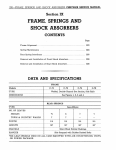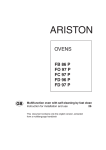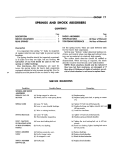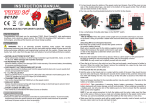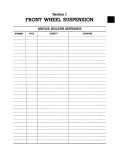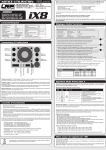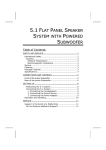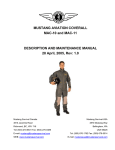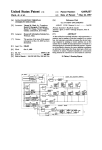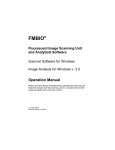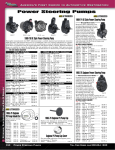Download FRAME, SPRINGS AND SHOCK ABSORBERS DATA
Transcript
CHRYSLER SERVICE MANUAL FRAME, SPRINGS AND SHOCK ABSORBERS—375 FRAME, SPRINGS AND SHOCK ABSORBERS DATA AND SPECIFICATIONS FRAME Models C-67 C-68 C-69 C-300 C-70 Welded, Double-Channel Box Section, Side Rails TYPE See Figures 1,2, 3 and 4 DIMENSIONS REAR SPRINGS TYPE Semi-Elliptic NO. OF LEAVES SEDANS 5 6 6 7 7 STATION WAGON 7 7 — — — WIDTH 2.5 2.5 2.5 2.5 2.5 LENGTH 55" 55" 55" 55" 55" SHACKLE Silent Block Rubber Bushings HANGER Side Strapped With Rubber Bushed Bolts SHOCK ABSORBERS Oriflow, Double Acting, Hydraulic TYPE Foot-Pounds TORQUE SPECIFICATIONS 60 REAR SPRING SILENT BLOCK NUT UPPER SHOCK ABSORBER STUD NUT i/2" LOWER 60 ... 70 REAR SPRING U-CLIP BOLT NUTS 70 REAR SPRING SHACKLE NUTS % 6 " 50 SWAY BAR BRACKET TO FRAME BOLTS 55 SWAY BAR SHAFT RETAINER TO CONTROL ARM BOLT NUT 55 ESSENTIAL TOOLS C-3413 .Remover and Installer—Shock Absorber Lower Mounting Assembly 376—FRAME, SPRINGS AND SHOCK ABSORBERS CHRYSLER SERVICE MANUAL 48% NOTE GAUGE HOLE DIMENSIONS ARE SHOWN AS INCHES AND ARE PLUS OR MINUS K6 UNLESS OTHERWISE NOTED TOP OF FRAME LINE 7% 1 TOP OF FRAME LINE GAUGE HOLE IN EACH SIDE OF FRAME 55x37 Fig. 1 — Frame Dimensions (Windsor and New Yorker) trr, "OX-IE 41% 30V4 42ff6 58 47/s 29^6 52V4 48^6 NOTE DIMENSIONS ARE SHOWN AS INCHES AND ARE PLUS OR MINUS K 6 UNLESS OTHERWISE NOTED TOP OF FRAME LINE GAUGE HOLE IN EACH SIDE OF FRAME TOP OF FRAME LINE \ 7" 55x38 Fig. 2 — Frame Dimensions (Custom Imperial) CHRYSLER SERVICE MANUAL FRAME, SPRINGS AND SHOCK ABSORBERS—377 Section IX FRAME, SPRINGS AND SHOCK ABSORBERS FRAME 1. DESCRIPTION Double channel box type frames are used on all 1955 Chrysler Models. The frames are rigidly reinforced with lap welled crossmembers. The rear engine support is removable and of the open channel design with double flange instead of single. If the frame becomes misaligned due to a collision, stresses may result which may affect the normal operation of rear axle, body, front suspension and other chassis units. A misaligned frame can cause body and door opening misalignment. Any attempt to cold-straighten a severely bent frame may cause rupture of the welds (if any) and may also cause the bent portions to 58M 6 crack. If heat is required to straighten a frame member, do not heat the member to more than a dull red color. Strength and frame hardness may be reduced if excess heat is applied to the frame during straightening processes. After a bent frame has been straightened, inspect it closely for cracks or strains. If any defects are apparent the frame should either be reinforced or replaced. If a damaged or cracked frame is to be reinforced, the crack should be prepared to insure a good weld. To prevent the crack from spreading, it is advisable to drill a VH inch hole at the root of the crack. Grind or enlarge the crack so as to insure weld penetration to the surface of the reinforcement. 47'f<6 4 1 % 55VA NOTE DIMENSIONS ARE SHOWN AS INCHES AND ARE PLUS OR MINUS X6 UNLESS OTHERWISE NOTED TOP OF FRAME LINE 5 7 /64iH TOP OF FRAME LINE 1 ^ GAUGE HOLE IN EACH SIDE OF FRAME TT TT 217H Fig. 3—Frame Dimensions (Crown Imperial) 55x39 378—FRAME, SPRINGS AND SHOCK ABSORBERS 2. CHECKING FRAME ALIGNMENT The diagrams shown in Figures 1, 2, 3 and 4 will greatly assist in checking the alignment of a car frame that has been distorted by collision or otherwise. In case of collision, frame members can often be satisfactorily straightened to the required limits. Since the front crossmember, brace and upper control arm support are made to unusually close limits, necessary for proper front wheel alignment, straightening of these units may not be successful. It is possible that ordinary straightening methods will suffice for minor damage. In case of serious damage or fracture, however, the entire front suspension crossmember, brace and support must be replaced. Before the member is replaced, it is essential that the frame alignment be checked and corrected if necessary. Whenever possible, the parts should be securely fastened with hot rivets. In cases where no riveting equipment is available, finished bolts snugly fitted in reamed holes may be used. The nuts should be securely tightened and non-spreading lockwashers used. (Cold rivets are not recommended unless adequate power press equipment is available to do a secure riveting job.) When welding frame members, care must be taken to localize the heat so that the steel hardness of frame will be retained. Reinforcement welds should run lengthwise, along the side of the reinforcement. Figures 1, 2, 3 and 4 show the various dimensions to be used as a guide for checking frame alignment. These dimensions are the true distance between the two points as measured with a steel tape. CHRYSLER SERVICE MANUAL Figure 4 shows a few of the various measurements that may be taken to check the "squareness" of the frame. Diagonal measure will quickly determine which section of the frame is bent and where force should be applied to restore correct alignment. 3. FRAME ALIGNMENT To properly check a frame for alignment, diagonal measurement should be performed with great care. When the body is removed, the frame may be easily checked for alignment by measuring diagonals, as shown in Figure 4, with trammels or steel tape and checking dimensions given in Figure 1, 2 and 3. Measurements may be taken without removing the body from the chassis by using a plumb-bob and chalk line on a level floor. Attach the line of a plumb-bob to the center of one of the rear body bolts. The plumb-bob should be suspended slightly above the floor. When the plumb-bob comes to rest, mark the floor directly underneath it. The marks made on the floor will represent various points of the frame to be checked diagonally. Move the car away so that the distance can be measured to compare with the diagonal measurements, shown in Figures 1, 2, 3, and 4. 4. REPLACING BODY SUPPORT BRACKETS (1) The body support brackets are welded to the frame in manufacturing. Due to the "Box" construction of the frame, rivets cannot be used to attach a new body bracket to the frame. 55x40 Fig. 4—Typical Frame Diagonal Measurements CHRYSLER SERVICE MANUAL FRAME, SPRINGS AND SHOCK ABSORBERS—379 (2) Cut the damaged bracket off the frame, file surface smooth. Clamp the new bracket in the correct position and weld securely to the frame member. is localized and burning of material is held to a minimum when a mild steel welding rod is used. (3) The shielded arc-weld method is recommended for frame welding, or the replacement of body frame support brackets. The heat generated from the welding operation (4) Install the body bolt and washers, insulator and nut. Tighten to 18 foot-pounds torque. On Convertibles, install a solid spacer, bolt and nut, and tighten securely. SPRINGS 5. DESCRIPTION The rear springs used on Chrysler cars are of the semi-elliptical design. The front ends of the rear springs are mounted to removable hangers which are bolted to brackets welded to the outer surface of the frame side rails. (See Fig. 5.) The spring front pivot bolts are cushioned in rubber which tends to help reduce noise and allows increased riding comfort through a reduction in torque and brake reaction shock. (No lubrication is required at this point.) The rear ends of the springs are attached to the frame through the medium of flat plate shackles, rubber shackle bushings, shackle bolts and nuts. (See Fig. 6.) Thus, the suspension of the rear springs in rubber, tends to reduce road noise to a minimum. (No lubrication is required at the rear shackles.) The width of the spring leaves are 2*/> inches (refer to Data and Specifications). Thus, with outboard-mounted rear springs, rear-end roll is greatly reduced and car stability on curves or sharp turns is maintained. Should it become necessary to install new springs or silent blocks, it will be necessary to remove the four bolts, nuts and lockwashers that hold the spring hanger to the frame bracket. The pivot bolts cannot be removed unless this is done. 6. SPRING MAINTENANCE It is important that spring "U" bolts be inspected at regular intervals and kept tight to prevent spring breakage. Tighten spring "U" bolt nuts to 70 foot-pounds torque. The spring shackles should be inspected occasionally to make sure they are tight, but not binding. Tighten to 50 foot-pounds torque. No lubrication of any kind must be used on rubber bushings. SPRING ASSEMBLY 56x53 Fig. 5—Rear Spring Front Mounting Front spring heights may be affected if the rear spring height varies more than % inch on one side as compared with the other side. To check this, measure the vertical distance from the top of the rear spring main leaf to the underside of the frame side rail on both sides of the 3S0—FRAME, SPRINGS AND SHOCK ABSORBERS CHRYSLER SERVICE MANUAL I "8 no _o a. X i. to o Q_ 3 CHRYSLER SERVICE MANUAL FRAME, SPRINGS AND SHOCK ABSORBERS—381 car. If these distances differ by more than % inch, this is an indication that one of the rear springs should be replaced. This condition could be due to a bent frame kick-up or an incorrectly welded spring saddle. 7. REPLACEMENT OF REAR SPRING INTERUNERS The 1955 Chrysler rear springs are similar to those previously used with the exception of the rear spring interliners. To replace the interliners, proceed as follows: a. Removal (1) Unload the rear springs by jacking up the rear end of the frame until the rear shock absorbers are fully extended. (2) Remove the alignment clips from the springs. If any of the removed parts (nut, bolt, spacer, clip) are damaged, use corresponding replacement parts. (3) Examine the spring interliners. If any of them are missing, or if any of them have lost their metal fasteners, they must be replaced. For replacement of these interliners, proceed as outlined below. (4) Pry out the metal fasteners directly beneath the spring leaf surface and slip out the old interliner, after separating the spring leaf to which the interliner was fastened from the next longer spring leaf. To effect this separation, pry open the slight Fig. 7—Separating Spring Leaf Fig. 8—Positioning New Interliners gap between the leaves with a screwdriver until a tapered bar can be hammered in place between the screwdriver and the interliner as shown in Figure 7. Keep the tapered bar in place. (5) Clean the lower (grooved) surface of the longer spring leaf as far as the interliner makes contact. Use sandpaper wrapped around a flat file and scrub vigorously to remove any dirt or rust spots and to obtain smooth metallic surfaces to the left and right of the groove. Wipe off excess particles, including dirt in the groove itself, with a clean cloth. In order to reach between the leaves, open the gap by bearing down on the end of the tapered bar. Fig. 9—Prying Interliner Fastener Through Leaf 382—FRAME SPRINGS AND SHOCK ABSORBERS Fig. 10—Positioning Wrap-Around Aligning Clip b. Installation of Interliner (1) Slip the new interliner in place by opening the gap between the spring leaves again with the tapered bar and moving the interliner until the prongs of the metal fasteners are aligned with the holes in the shorter leaf, as shown in Figure 8. (2) With the tapered bar still in place, pry the prong end of each metal fastener through the hole in the spring leaf, as shown in Figure 9. (3) Remove the tapered bar which has remained between the leaves during these operations. The bar may be withdrawn CHRYSLER SERVICE MANUAL Fig. 11—Tightening Aligning Clip while a screwdriver is placed alongside. Then the screwdriver may be pulled out, reversing the operation which was used to insert the bar in position. A faster method for withdrawing the bar is to insert the end of a bar with a short tapered hook alongside the tapered bar. After the tapered bar has been withdrawn, the bar with the hook can be slipped out easily using leverage motion inward on the far end of the hooked bar. (4) Position the wrap-around alignment clip and tighten retainer nut, as shown in Figures 10 and 11. Peen the end of the bolt over the nut so it will not loosen. SHOCK ABSORBER a. DESCRIPTION Chrysler cars are equipped with double acting Oriflow shock absorbers as shown inr Figures 12 and 13. Oriflow shock absorbers cannot be disassembled for servicing. If test reveals the shock absorber is not functioning properly, it must be replaced as a complete unit. The shock absorber is a device which provides control of the spring's movement and dissipates the majority of the energy, which would otherwise be stored in the springs, resulting in passenger discomfort and lack of stability. The shock absorber converts the energy of the spring into friction when the fluid in the CHRYSLER SERVICE MANUAL FRAME, SPRINGS AND SHOCK ABSORBERS—383 When road testing, drive the car over a fairly rought road first to test the resistance under fast shock absorber piston speed. Then drive over a fairly smooth road to test the resistance during slower shock absorber piston speeds. FLATS O N RO STEEL SLEEVE INSULATOR BUSHING SHOCK ABSORBER ASSEMBLY M O U N T I N G BRACKET A N D INSULATOR ASSEMBLY Hand testing Oriflow shock absorbers will only reveal complete failure. The amount of ride control evident from a hand test on the bench is small, compared with the control exerted under actual riding conditions. For this reason, it is impossible to feel any sudden resistance in an Oriflow shock absorber, no matter how fast it is operated by hand. 11. REMOVAL AND INSTALLATION OF FRONT SHOCK ABSORBER 54x619 Fig. 12—Front Shock Absorber a. Removal Refer to Figure 14 and then proceed as follows: shock absorber is forced to escape through the restricted passages, causing the spring to return to its normal position without shock to the body. (1) Raise the hood and remove dirt or grease from around the shock absorber upper mounting area. 9. OPERATION (2) Slide a *4 inch wrench over the flats on the top of shock absorber piston rod, to keep rod from turning. Now, remove nut and cup washer. In the Oriflow shock absorber, the resistance is built up slowly at the beginning of the stroke so as not to jolt the passengers. This resistance is increased to a maximum at a mid stroke and is tapered off to zero at the end of the movement. The major part of the dampening is accomplished at the high velocity mid-portion of the stroke where no jolt can originate. There can be little jolt at the beginning and at the end of the stroke because both the velocities of movement and the resistance offered by the shock absorber are low at those points. Mounting the shock absorbers within the coil spring allows for softer dampening action and more complete front-end control. 10. TESTING ORIFLOW SHOCK ABSORBERS Oriflow shock absorbers are designed to operate with low resistance when operated slowly and with high resistance when operated rapidly. Since they operate with little resistance when compressed by hand or by bench test methods, their true operating efficiency can be determined best by a road test. It is impossible to determine the operating efficiency of Oriflow shock absorbers by rocking the car by the bumper. (3) Remove the two lower mounting bolts, then withdraw shock absorber through opening in the bottom of spring seat. The lower cup washer may remain in place or drop through when shock absorber is removed. (4) Using a suitable drift, force the inner steel sleeve out of bushing, then remove bushing from frame opening. Check bushing for deterioration or fatigue. Install new bushing. (5) Before installing new bushing, dip bushing in soapy water, then insert in position in frame, using a twisting motion. When installed properly, the groove in bushing will index with frame. (6) Now force steel sleeve through opening in bushing and down into position. (7) Remove the mounting bracket from the shock absorber eye using Tool C-3413. Press mounting bracket and bushing out of eye. The mounting bracket and bushing are serviced as an assembly only. 384—FRAME, SPRINGS AND SHOCK ABSORBERS CHRYSLER SERVICE MANUAL PISTON ROD OIL SEAL CAP SEAL RETAINER OIL SEAL GASKET PISTON ROD OIL SEAL OIL SEAL SPRING ROD GUIDE DUST SHIELD COMPRESSION RELIEF VALVE PISTON NUT CYLINDER PISTON TUBE RESERVOIR TUBE CHECK VALVE CHECK VALVE SPRING CHECK VALVE SEAT RING AND CUP ASSEMBLY Fig. 13—Rear Shock Absorber (Sectional View) 54X&4 CHRYSLER SERVICE MANUAL FRAME, SPRINGS AND SHOCK ABSORBERS—385 UPPER MOUNTING SHOCK ABSORBER ASSEMBLY LOWER MOUNTING ASSEMBLY SCREW •LOCK WASHER 55P1014 Fig. 14—Front Shock Absorber Installed Fig. 15—Rear Shock Absorber Installed b. Installation To install a new mounting bracket and bushing, refer to Figure 14 and proceed as follows: (1) Position the new mounting bracket so that the mounting holes are at a right angle to the shock absorber. Using Tool C-3413, press mounting bracket into eye until centered. CAUTION: Always press against steel sleeve to avoid damage to the assembly. (2) Extend the shock absorber piston rod to its full travel, and slide lower cup washer (concave side up) over rod and down into position. (3) Slide shock absorber up through opening in spring seat (be sure the extended piston rod enters steel sleeve through upper bushing) , and up into position. Install retaining bolts and tighten to 35 foot-pounds torque. (4) Slide cup washer (concave side down) over piston rod and down on bushing. Install nut, and tighten to 35 foot-pounds torque, or until the upper and lower concave washers bottom against steel sleeve. 12. REMOVAL AND INSTALLATION OF REAR SHOCK ABSORBERS (Fig. 15) To remove a shock absorber, remove nuts from pins which pass through eyes at top and bottom of shock absorber. Slide unit off pins. When installing a shock absorber, first install the bushings in the shock absorber's eyes. Install the inner bushing retainers, the shock absorber and bushing assembly and the outer retainers. The concave face of each retainer must fit against the convex face of the adjacent bushing.












